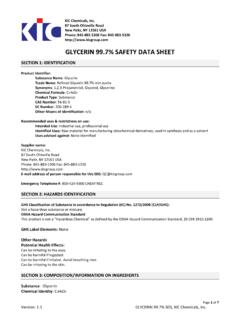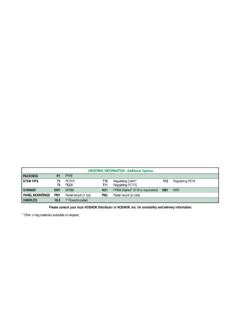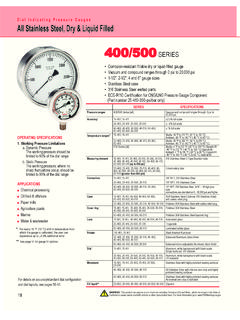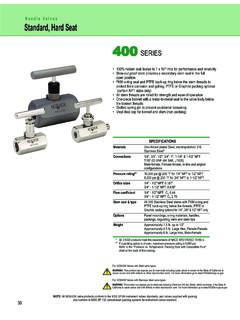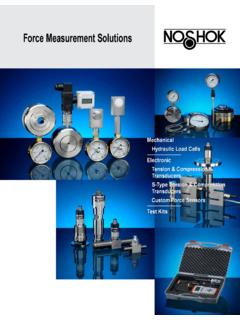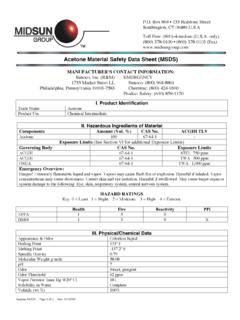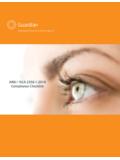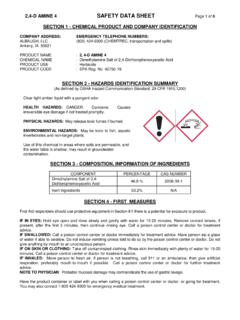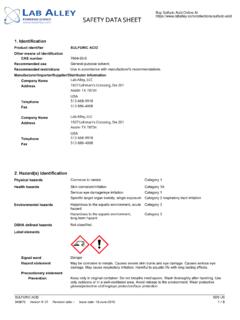Transcription of GLYCERIN 99.7% SAFETY DATA SHEET - NOSHOK
1 Page 1 of 7 Version: GLYCERIN SDS, KIC Chemicals, Inc. KIC Chemicals, Inc. 87 South Ohioville Road New Paltz, NY 12561 USA Phone: 845-883-5306 Fax: 845-883-5326 GLYCERIN SAFETY data SHEET SECTION 1: IDENTIFICATION Product Identifier: Substance Name: GLYCERIN Trade Name: Refined GLYCERIN min purity Synonyms: 1,2,3-Propanetriol, Glycerol, Glycerine Chemical Formula: C3H8O3 Product Type: Substance CAS Number: 56-81-5 EC Number: 200-289-5 Other Means of Identification: n/a Recommended uses & restrictions on use: Intended Use: Industrial use, professional use Identified Uses: Raw material for manufacturing oleochemical derivatives.
2 Used in synthesis and as a solvent Uses advised against: None identified Supplier name: KIC Chemicals, Inc. 87 South Ohioville Road New Paltz, NY 12561 USA Phone: 845-883-5306 Fax: 845-883-5326 E-mail address of person responsible for this SDS: Emergency Telephone #: 800-424-9300 CHEMTREC SECTION 2: HAZARDS IDENTIFICATION GHS Classification of Substance in accordance to Regulation (EC) No. 1272/2008 (CLP/GHS): Not a hazardous substance or mixture. OSHA Hazard Communication Standard This product is not a Hazardous Chemical as defined by the OSHA Hazard Communication Standard, 29 CFR GHS Label Elements: None Other Hazards Potential Health Effects: Can be irritating to the eyes.
3 Can be harmful if ingested. Can be harmful if inhaled. Avoid breathing mist. Can be irritating to the skin. SECTION 3: COMPOSITION/INFORMATION ON INGREDIENTS Substance: GLYCERIN Chemical identity: C3H8O3 Page 2 of 7 Version: GLYCERIN SDS, KIC Chemicals, Inc. Common name/Synonyms: 1,2,3-Propanetriol, Glycerol, Glycerine Ingredient name CAS number EC number % EU Classification GHS Classification GLYCERIN 56-81-5 200-289-5 min Not Classified Not Classified Impurities and Stabilizing Additives There are no additional ingredients present which, within the current knowledge of the supplier and in the concentrations applicable, are classified as hazardous to health or the environment and require reporting in this section.
4 Occupational exposure limits, if available, are listed in section 8. SECTION 4: FIRST AID MEASURES Description of First Aid Measures General Advice: Never give anything by mouth to an unconscious person. If you feel unwell, seek medical advice (show the label where possible). Take care to self-protect by avoiding becoming contaminated. Most Important Symptoms and Effects, Both Acute and Delayed Symptoms/Injuries after inhalation: ON HEATING: Irritation of the respiratory tract. Irritation of the nasal mucous membranes. Symptoms/Injuries after skin contact: n/a Symptoms/Injuries after eye contact: Redness of the eye tissue. Lacrimation. Symptoms/Injuries after ingestion: Nausea.
5 Vomiting. Diarrhea. AFTER ABSORPTION OF HIGH QUANTITIES: Headache. Dehydration. Disturbances of heart rate. Change in the aerogramme/blood composition. Decreased renal function. Description of First Aid Measures First-aid measures after inhalation: Remove the victim into fresh air. If signs/symptoms continue, get medical attention. Give oxygen or artificial respiration as needed. First-aid measures after skin contact: wash immediately with lots of water (15 minutes)/ shower . Soap may be used. Remove clothing before washing. First-aid measures after eye contact: Rinse immediately with plenty of water for 15 minutes. Take victim to an ophthalmologist if irritation persists.
6 First-aid measures after ingestion: DO NOT induce vomiting. If vomiting does occur, have victim lean forward to prevent aspiration. Rinse mouth with water. Seek medical attention. Never give anything by mouth to an unconscious individual. Ingestion of large quantities: immediately to hospital. Indication of Any Immediate Medical Attention and Special Treatment Needed If medical advice is needed, have product container or label at hand. All treatments should be based on observed signs and symptoms of distress in the patient. Consideration should be given to the possibility that overexposure to materials other than this product may have occurred. SECTION 5: FIRE-FIGHTING MEASURES Extinguishing Media Suitable extinguishing media: Use dry powder, foam, carbon dioxide for extinguishing.
7 Unsuitable extinguishing media: None Special Hazards Arising from the Substance or Mixture Fire hazard: DIRECT FIRE HAZARD. Combustible, keep away from open flame, no smoking. INDIRECT FIRE HAZARD. Temperature above flashpoint: higher fire/explosion hazard. Explosion hazard: No direct explosion hazard. Reactivity: Decomposes on exposure to temperature rise: release of toxic/corrosive/combustible gases/vapors (acrolein). Upon combustion CO and CO2 are formed. May polymerize on exposure to temperature rise. Reacts violently with (strong) oxidizers: (increased) risk of fire/explosion. Reacts with (some) acids: (increased) risk of fire/explosion. Page 3 of 7 Version: GLYCERIN SDS, KIC Chemicals, Inc.
8 Advice for Firefighters Firefighting instructions: Exercise caution when fighting any chemical fire. Protection during firefighting: Firefighters should wear full protective gear. Use self-contained breathing equipment if in confined place. Do not enter fire area without proper protective equipment, including respiratory protection. Other Information: Refer to Section 9 for flammability properties. SECTION 6: ACCIDENTAL RELEASE MEASURES Personal Precautions, Protective Equipment and Emergency Procedures General Measures: Mark the danger area. Exposure to heat: have neighborhood close doors and windows. Exposure to fire/heat: consider evacuation. wash contaminated clothes.
9 Use gloves, face shield For Non-emergency Personnel Protective equipment: Use appropriate personal protection equipment (PPE). Emergency procedures: Evacuate unnecessary personnel. For Emergency Responders Protective equipment: Equip cleanup crew with proper protection. Use appropriate personal protection equipment (PPE). Emergency procedures: Ventilate area. Environmental Precautions Do not allow to flow into drainage system. Methods and Material for Containment and Cleanup For containment: Collect leakage in sealable containers, soak up with sand or other inert absorbent and remove to safe place. Flush away remainder with water. Methods for cleaning up: Clear up spills immediately and dispose of waste safely.
10 See Section 1 for emergency contact information. See Section 8 for information on appropriate personal protective equipment. See Section 13 for additional waste treatment information. SECTION 7: HANDLING AND STORAGE Precautions for Safe Handling Prevention of user exposure: Put on appropriate personal protective equipment. Use gloves and wear goggles when handling. Avoid breathing mist. Prevention of fire and explosion: Handling temperature 10 C above melting point Precautions while moving the product: Keep in the original container or an approved alternative made from a compatible material, kept tightly closed when not in use. Empty containers retain product residue and can be hazardous.
